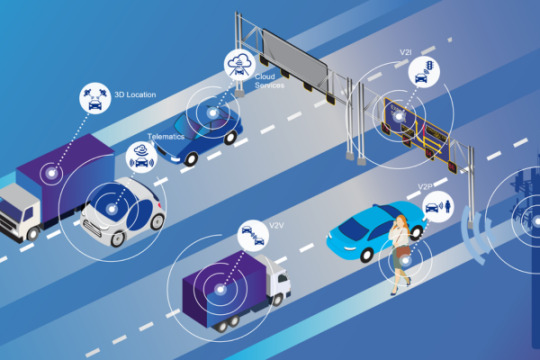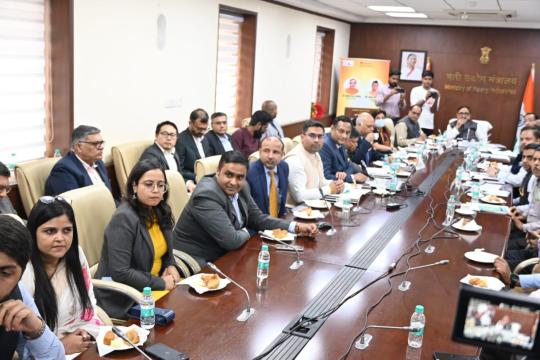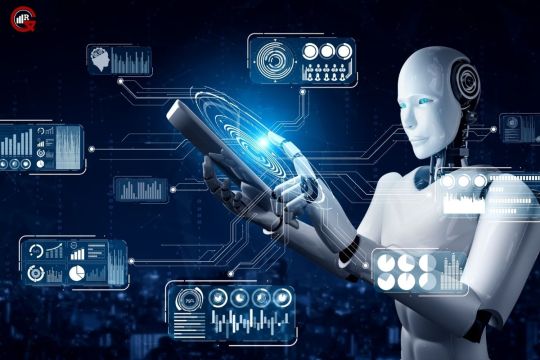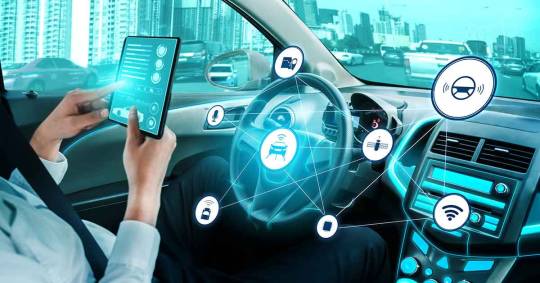#AutomotiveInnovation
Text
Stepping into the Metaverse: A Guide for Businesses in 2024

The metaverse is no longer science fiction. It's a rapidly developing virtual world with the potential to revolutionize the way we work, shop, and connect. But how can this digital landscape benefit your specific industry? Buckle up, because we're diving into the Metaverse for Industries and exploring its impact on various sectors.
Unearthing the Gems: How the Metaverse Can Benefit Your Industry
The metaverse isn't a one-size-fits-all solution. Its applications will vary depending on your field. Here's a glimpse into how different industries can leverage its potential:
Retail: Imagine a virtual mall where customers can browse through holographic clothing, try on outfits in virtual fitting rooms, and interact with sales staff avatars. The metaverse can transform retail into an immersive experience, boosting engagement and sales.
Education: Imagine attending a history lecture where you can walk through recreated historical landmarks or a biology class where you can dissect a virtual frog. The metaverse can create interactive and engaging learning experiences, making education more accessible and impactful.
Manufacturing: Imagine conducting virtual tours of factories, simulating product design and testing in a digital environment, or even holding remote team meetings in a collaborative 3D workspace. The metaverse can streamline manufacturing processes, improve communication, and reduce costs.
Healthcare: Imagine attending therapy sessions in virtual reality environments, conducting remote surgery simulations, or even offering virtual rehabilitation programs. The metaverse has the potential to revolutionize healthcare by providing new avenues for treatment, training, and patient care.
These are just a few examples, and the possibilities are truly endless. The metaverse can be a game-changer for industries like marketing, engineering, construction, and even legal services.
Navigating the Maze: Challenges of Adopting the Metaverse for Business

While the metaverse Industry Development Company is brimming with opportunities, there are challenges to consider:
Technological limitations: The metaverse is still under development. Issues like latency, accessibility of VR equipment, and the need for robust internet infrastructure can hinder widespread adoption.
Data security and privacy: The metaverse will generate vast amounts of user data. Businesses need to ensure robust security measures to protect user privacy and prevent data breaches.
Standardization and interoperability: Currently, there's no single metaverse platform. Different platforms may not interact seamlessly, creating challenges for businesses trying to build a metaverse presence.
User acceptance and digital literacy: Not everyone is comfortable with virtual environments. Businesses need to consider user adoption rates and bridge the digital divide to ensure successful metaverse integration.
VR headset or Just a Headset? Does Entering the Metaverse Require Expensive Equipment?
Not necessarily! While VR headsets provide an immersive experience, the metaverse is not limited to them. Augmented reality (AR) glasses, mixed reality (MR) devices, and even standard computers with good internet connection will likely be gateways into the metaverse. As technology advances, we can expect more affordable and accessible ways to interact with this virtual world.
Building Your Metaverse Manor: How Can Businesses Create a Presence?

Here's a roadmap to establish your business in the metaverse Development Services:
Define your goals: What do you hope to achieve in the metaverse? Do you want to create a virtual showroom, host interactive events, or provide customer service? Having a clear vision is crucial.
Choose your platform: Research metaverse platforms that align with your target audience and goals. Consider factors like user base, functionality, and development tools.
Develop your virtual space: This could be a virtual store, a training facility, or a co-working space. Design it to be user-friendly, engaging, and reflective of your brand identity.
Content is king: Create high-quality content that engages users in the metaverse. This could include interactive games, product demonstrations, or educational experiences.
Foster a community: The metaverse thrives on interaction. Build a community around your virtual space by hosting events, contests, and offering opportunities for user engagement.
The Future of Work: Will We Be Clocking In From the Metaverse?

The metaverse Development Company has the potential to reshape the future of work. Here's how:
Remote collaboration: Imagine attending meetings and brainstorming sessions in a virtual workspace, regardless of physical location. The metaverse can foster seamless remote collaboration across teams and continents.
Employee training and development: Imagine practicing surgical procedures in a virtual environment or learning new skills through interactive simulations. The metaverse can provide immersive and engaging training experiences for employees.
Improved work-life balance: The metaverse can create a clear distinction between the physical workplace and the virtual one. This can lead to better work-life balance for employees.
However, there are also challenges to consider, such as potential feelings of isolation and the need for clear regulations regarding remote work in the metaverse.
#MetaverseManufacturing#VirtualRetail#HealthcareMetaverse#MetaverseRealEstate#EdTechMetaverse#FintechMetaverse#AutomotiveInnovation
0 notes
Link
The last week of May 2024 was a whirlwind of exciting car news, from the official launch of powerful new models to intriguing glimpses of upcoming electric vehicles (EVs) and hot hatches. Let's buckle up and take a deep dive into the hottest stories that got car enthusiasts buzzing: Car News from May 27-31 Tata Altroz Racer: Ready to Scorch the Streets Gearheads, rejoice! Tata Motors has finally confirmed the arrival of the much-anticipated Altroz Racer with a series of teasers. This hot hatch promises to deliver thrilling performance and head-turning design, building upon the success of the standard Altroz. Eager customers can secure their Altroz Racer by placing an offline reservation at select Tata dealerships for a nominal fee. Expect the Altroz Racer to boast sporty design cues inside and out, along with the proven power of the Nexon's 1.2-liter turbo-petrol engine churning out 120 PS. Mahindra XUV.e8: Electric Ambition Takes Shape The Mahindra XUV.e8, the electric avatar of the popular XUV700, has been creating a stir during its test runs. To heighten the anticipation, Mahindra has filed patents for a futuristic-looking steering wheel and a three-screen integrated dashboard layout. The patent hints at an octagonal steering wheel design with two spokes and a potentially illuminated Mahindra logo at its center. The three-screen dashboard configuration, if implemented, would integrate the instrument cluster, infotainment system, and a dedicated passenger screen, creating a truly tech-savvy driving experience. Tata Curvv: Spy Shots Reveal Sleek Taillights The internet has been abuzz with spy shots of the upcoming Tata Curvv coupe-SUV. This time, the spotlight falls on the SUV's sleek taillights. These connected LED taillights bear a striking resemblance to those showcased on the Curvv concept unveiled in February 2024. Expect dynamic features like welcome and goodbye animations, along with sequential turn indicators, similar to what we've seen on recent Tata car updates. Skoda-Volkswagen Celebrates Manufacturing Milestone in India Skoda Auto Volkswagen India has a reason to celebrate! The group has surpassed a significant production milestone by rolling out over 15 lakh cars in India. This impressive feat includes 3 lakh units of the Skoda Kushaq and Slavia, along with their Volkswagen counterparts, the Taigun and Virtus. Furthermore, the Chakan plant has churned out over 3.8 lakh engines, solidifying its commitment to "Make in India." Adding another layer to their success story, Skoda-VW India has exported a remarkable 30% of their India-made vehicles to over 40 countries, showcasing the global appeal of their cars. Porsche Unleashes Powerful New 911 Models in India Porsche aficionados, prepare to be thrilled! The iconic German automaker has launched the much-awaited 911 Carrera and 911 Carrera 4 GTS in India. The 911 Carrera boasts a revamped 3-liter twin-turbo flat-six engine delivering a mighty 394 PS and 450 Nm of torque. Gear up for even more power with the 911 Carrera 4 GTS, featuring a new 3.6-liter turbocharged T-hybrid engine that pumps out an impressive 541 PS and 610 Nm. The GTS exterior differentiates itself with active-aero components at the front and a sporty exhaust setup at the rear. Stepping inside, both models showcase a fully digital driver's display and an upgraded infotainment system, ensuring a technologically advanced driving experience. Audi Q6 e-tron Performance Unveiled: A More Affordable Electric Option Calling all eco-conscious drivers with a sporty edge! Audi has unveiled a new addition to the Q6 e-tron family - the Q6 e-tron Performance variant. This rear-wheel-drive model prioritizes affordability by featuring a single electric motor positioned on the rear axle. The motor, paired with a 100 kWh battery, delivers a respectable 326 PS and a commendable range of 641 km. This new variant boasts a 0-100 mph acceleration time of 6.6 seconds, slotting in between the Q6 e-tron Quattro and the performance-oriented SQ6 e-tron. While details about the interior haven't been revealed yet, it's likely to mirror the cabin and features of its siblings in the Q6 e-tron lineup. FAQs: Q: When will the Tata Altroz Racer be launched? A: An official launch date hasn't been announced yet, but teasers suggest the Altroz Racer's arrival is imminent. Stay tuned to Tata Motors' official channels for the confirmed launch date. Q: What are the key features of the Mahindra XUV.e8's patented dashboard layout? A: Based on the patent, the XUV.e8 might feature a futuristic-looking octagonal steering wheel with two spokes and a potentially illuminated Mahindra logo in the center. The three-screen dashboard layout, if implemented, would integrate the instrument cluster, infotainment system, and a dedicated passenger screen for a tech-forward driving experience. Q: What kind of taillights will the Tata Curvv have? A: Spy shots reveal the Tata Curvv will likely sport sleek connected LED taillights similar to those showcased on the concept model. Expect features like welcome and goodbye animations, along with sequential turn indicators. Q: How many cars has Skoda Auto Volkswagen India produced so far? A: Skoda Auto Volkswagen India has surpassed a significant milestone by producing over 15 lakh cars in India. This includes popular models like the Skoda Kushaq, Slavia, Volkswagen Taigun, and Virtus.
#AudiQ6etronPerformance#automotiveinnovation#carnews#CarNewsfromMay2731#electricmobility#MahindraXUV.e8#Patenting#Porsche911Carrera#SkodaVWGroup#SpyShots.#TataAltrozRacer#TataCurvv
0 notes
Text
Honda Commits $65 Billion To Advance Electric Vehicle Technology And Software Development

(Source – VLK Architects)
Strategic Investment Aims to Propel Honda’s Transition to Electric Mobility
Honda Motor, a prominent figure in Japan’s automotive industry, has announced ambitious plans to escalate its investment in electric vehicle (EV) technology and software development. With a commitment of approximately $65 billion over the next decade, Honda is positioning itself to accelerate its adoption of electric mobility and fortify its competitive stance in the swiftly evolving automotive sector.
Ramping Up Investment in Electric Vehicle Technology and Software
Toshihiro Mibe, Honda’s CEO, unveiled the company’s strategy to double down on investment in electrification and software, earmarking a colossal sum of 10 trillion yen ($64.88 billion) by the close of the 2030 business year. This substantial augmentation in investment underscores Honda’s recognition of the pivotal role played by electrification and software-driven vehicles in shaping the automotive landscape of tomorrow.
Emphasis on Innovation and Performance Enhancement
Mibe underscored Honda’s unwavering commitment to innovation and performance enhancement, particularly in the realm of electric vehicles. The company aims to introduce a new line of battery-powered vehicles from 2026 onward, boasting an impressive cruising range exceeding 300 miles (482 km). Equipped with state-of-the-art technologies such as an ultra-thin battery pack and a newly developed compact e-axle, these vehicles are poised to deliver enhanced efficiency and performance.
Driving Cost Reduction and Enhancing Competitiveness
In addition to technological advancements, Honda is prioritizing cost reduction initiatives to bolster its competitiveness in the Electric Vehicle market. The automaker has set ambitious targets for cost savings in battery procurement and production expenses, with projected reductions of over 20% and approximately 35%, respectively, by 2030. These measures are integral to enhancing Honda’s cost efficiency and positioning it as a formidable contender in the global EV landscape.
Navigating the Competitive Terrain
As Honda intensifies its push towards electrification, it faces formidable competition from established automakers and emerging EV manufacturers alike. With rivals such as Toyota, Tesla, and Chinese automakers like BYD making significant strides in the EV market, Honda is gearing up for a strategic thrust to catch up and assert its presence in this transformative phase of automotive innovation.
Honda’s ambitious investment plans mark a decisive stride towards realizing its vision of a sustainable and technology-driven future. With a renewed focus on electrification and software development, Honda is poised to spearhead the next wave of automotive mobility, cementing its position as a leader in the electric vehicle revolution.
0 notes
Text
Unleashing Power and Reliability: Exploring AKMI Corp's Diesel Engine Parts
In the dynamic world of diesel engines, optimizing performance and ensuring longevity are non-negotiables. Whether it's for commercial fleets, heavy-duty machinery, or recreational vehicles, diesel engines serve as the backbone of numerous industries globally. However, maintaining peak performance and extending the lifespan of these engines can be challenging. This is where AKMI Corp's aftermarket diesel engine parts step in to revolutionize the game.

AKMI Corp is a renowned name in the aftermarket parts industry, known for its commitment to excellence and innovation. Their lineup of aftermarket diesel engine parts offers diesel engine owners a plethora of benefits, including enhanced performance, increased durability, and cost-effectiveness.
One of the most significant advantages of AKMI Corp's aftermarket diesel engine parts is their ability to elevate performance to new heights. These parts are meticulously engineered with cutting-edge technologies and innovative features designed to unleash the full potential of diesel engines. Whether it's a high-flow air intake system, a performance exhaust system, or a tuning chip, AKMI Corp's aftermarket parts can significantly boost horsepower, torque, and overall efficiency. The result? Improved acceleration, towing capacity, and fuel economy that propel diesel-powered vehicles and machinery to greater heights.
Moreover, AKMI Corp's aftermarket diesel engine parts are built to withstand the rigors of heavy-duty usage. Premium materials and rigorous testing ensure that AKMI Corp's aftermarket parts deliver unparalleled reliability in even the most demanding conditions. Diesel engine owners can trust AKMI Corp parts to provide consistent performance and longevity, ensuring peace of mind and confidence in their vehicles and equipment.

Another compelling aspect of AKMI Corp's aftermarket diesel engine parts is their cost-effectiveness. AKMI Corp offers comparable quality at a fraction of the cost. This affordability makes it easier for diesel engine owners to maintain and upgrade their vehicles without breaking the bank. Additionally, AKMI Corp stands behind the quality of their products, offering warranties and guarantees that further instill trust and confidence in their aftermarket parts.
Furthermore, AKMI Corp's commitment to innovation and excellence ensures that diesel engine owners have access to a diverse marketplace with plenty of options to choose from.
In conclusion, AKMI Corp's aftermarket diesel engine parts are a game-changer for diesel engine owners looking to enhance performance, durability, and affordability. Whether you're a commercial fleet operator, a construction contractor, or a diesel enthusiast, AKMI Corp's aftermarket diesel engine parts provide the means to unlock the full potential of your diesel-powered vehicles and equipment.
#AkmiCorp#IndustryLeadership#EngineSolutions#AutomotiveInnovation#QualityPerformance#VehicleComponents#EngineParts#AutomotiveExcellence
0 notes
Text
VCU Functionality And Control Systems
Introduction
VCU Functionality And Control Systems

1. Understanding the vehicle control unit or VCU
The Vehicle Control Unit (VCU), also known as the Electronic Control Unit (ECU), is a specialized electronic device that serves as the central controller for the vehicle. It uses information gathered from multiple sensors located throughout the car to make decisions in real time. The Vehicle Control Unit (VCU) is responsible for managing many control systems and subsystems to ensure the efficient and secure operation of the vehicle.
2. VCU Control Mechanisms and Features
2.1 Powertrain Control System:

2.2 System of Braking Control:
brake control system Another vital function that the VCU manages is the braking control system. It is composed of multiple subsystems, such as the Brake Assist (BA), the Anti-lock Braking System (ABS), and the Electronic Brake Force Distribution (EBD). For every wheel, the VCU continuously measures wheel speed, vehicle speed, and brake pedal input to determine the ideal braking force. This guarantees optimal braking efficacy and prevents skidding.
2.3 Electronic Control for Stability:
The stability control system, commonly known as Vehicle Stability Control (VSC) or Electronic Stability Control (ESC), is designed to maintain the vehicle’s stability during turns and in potentially dangerous driving conditions. Information is gathered by sensors monitoring lateral acceleration and wheel speeds to detect any vehicle loss of control. It then adjusts engine torque and applies selective brakes to particular wheels to help the driver regain control and prevent further mishaps.
2.4 Traction Control System:

2.5 System of Steering Control:
In automobiles with electric power steering, the VCU is a crucial part of the steering control system. The optimal amount of assistance required for precise and responsive steering is ascertained by utilizing the inputs from various sensors, including the steering angle sensor. Many state-of-the-art driver assistance systems, such as lane-keeping assist, depend on the VCU to provide precise steering control and retain the vehicle in its designated lane.
2.6 Control of Lighting and HVAC:
In addition, the VCU regulates lighting systems, including autonomous headlights and adaptive lighting, based on the amount of light outside and the speed of the driving car. It also maximizes energy efficiency by controlling the HVAC system to maintain a comfortable temperature within the cabin.
3. VCU Control Approaches
Complex control algorithms are largely responsible for VCU functionality. These algorithms, which are essentially collections of mathematical equations and standards for making decisions, govern how the VCU interprets data and makes decisions. Among the primary control algorithms of a VCU are the following:
3.1 Proportional-Integral-Derivative, or PID, Control:
PID control is a widely used technique in control systems to maintain a particular set point. As the actual output is continuously compared to the intended set point, the appropriate control actions are taken to reduce the error. PID control is widely used in powertrain and braking systems to regulate engine characteristics and brake pressure.
3.2 Control via Fuzzy Logic:
Rule-based fuzzy logic control is capable of handling uncertain and imprecise data. Particularly useful are human-decision-based control systems such as adaptive cruise control, in which the vehicle’s velocity control unit (VCU) adjusts the vehicle’s speed in reaction to changing road circumstances and driver preferences.
3.3 MPC, or model predictive control:
MPC is an advanced control method that optimizes control operations based on the prediction of future behavior using mathematical models of the system. It is widely utilized in stability control systems and vehicle dynamics control to guarantee the best handling and performance under changeable driving circumstances.
4. Integration of Advanced Driver Assistance Systems (ADAS)

5. The Future of VCU Functionality
It is expected that as vehicle technology advances, VCU functionality will undergo significant changes. Some recent advancements in VCU functionality include the following:
5.1 Advanced sensors and artificial intelligence (AI) combined with VCU are enabling capabilities for autonomous driving. A completely autonomous vehicle would depend on the VCU’s decision-making skills to function safely in the absence of human intervention.
5.2 Networking and Wireless Updates: VCUs may have better connections in the future, enabling them to get updates over the air and link to cloud-based systems. Manufacturers won’t need to physically recall any VCUs to add new features and improve their performance over time.
5.3 Energy Management and Efficiency Given the growing emphasis on sustainability, it is expected that VCUs would prioritize energy management and optimize power distribution to dramatically improve fuel economy and reduce emissions.
Conclusion
The vehicle control unit plays a major role in the safe and efficient operation of modern automobiles. Its functioning and control systems are capable of performing a wide range of tasks, including steering, brakes, stability, and powertrain control. As technology advances, the VCU will become more sophisticated, integrating state-of-the-art driver assistance technologies and establishing the foundation for autonomous driving. With a constant focus on safety, efficiency, and connection, VCUs will remain at the forefront of automotive innovation, ensuring that everyone has a safer and smarter driving experience.
For more information on our VCU Functionality and Control Systems, components, and software development skills for battery-specific applications, as well as to explore our superior VCU products and services, send an email to [email protected].
0 notes
Text
Revolutionizing Automotive Performance: Jato Dynamics Limited Leads the Way with Cutting-Edge Technology
Dive into the realm of automotive excellence with Jato Dynamics Limited, a trailblazer in vehicle performance innovation. Discover how their groundbreaking advancements are reshaping the driving experience. From enhanced fuel efficiency to superior handling, Jato Dynamics Limited sets the standard for excellence in automotive engineering. Join the movement towards a future where every ride is a masterpiece of efficiency and power.
0 notes
Text
Navigating the Roads Ahead: Exploring Android Automotive.
Exploring Android Automotive unveils a revolutionary platform that seamlessly integrates Android features into vehicles. With built-in Google services, customizable interface, and extensive app ecosystem, it promises enhanced connectivity, improved user experience, and future-proofing. As a transformative force in automotive technology, Android Automotive shapes the future of intelligent driving experiences.

Read More On Android Automotive.
#AndroidAutomotive#CarTech#ConnectedCars#AutomotiveInnovation#DigitalDriving#SmartCar#TechBlog#AndroidApps#CarTechnology#FutureOfMobility#TechInCars#AutomotiveTech#DigitalDashboard#SmartVehicle#AndroidDevelopment#cyberdefense
0 notes
Text

#AutomotiveIndustry#TireTechnology#Innovation#FutureMobility#SustainableTransport#SmartTires#AdvancedMaterials#TireDesign#GlobalMarket#AutomotiveInnovation#GreenTransport#Efficiency#SafetyFeatures#TireManufacturing#SmartMobility#TirePerformance
0 notes
Text
Ferrari gana las 24 Horas de Daytona ¿Funcionarán sus nuevas estrategias?
El golpe maestro estratégico de Ferrari: ya ganó Lemans en en 2023 y ahora en Daytona en 2024, el desafío es ahora revolucionar la dinámica de la Fórmula 1
En 2023 y 2024, Ferrari logró victorias estratégicas en Lemans y Daytona, lo que indica una posible revisión de la dinámica de la Fórmula 1.
Ferrari 499P LMHFerrari 499P LMHFerrari 499P LMHFerrari 499P LMH
Bajo el liderazgo del director…

View On WordPress
#AutomotiveInnovation#CharlesLeclerc#f1#F1News#ferrari#FerrariFuture#Formula1#ItalianExcellence#LewisHamilton#motorsport#RAcing#RacingRevolution
0 notes
Text





IIT Roorkee and the Ministry Of Heavy Industries (MHI), led by Minister Shri Mahendranath Pandey, have joined hands to establish a Center of Excellence and an Industry Accelerator on Automotive and Allied Research and Technology Innovations (AARTI). With CM Uttarakhand's Pushkar Singh Dhami presence, this collaboration underscores our commitment to Viksit Bharat, envisioned by PM Narendra Modi, propelling India towards automotive innovation and excellence.
#IITRoorkee#MinistryOfHeavyIndustries#AARTI#AutomotiveInnovation#ViksitBharat#PMModi#MahendranathPandey#CMUttarakhand#ResearchAndDevelopment#TechnologyInnovation#Director IIT Roorkee#MINISTRY OF EDUCATION#GOVERNMENT OF INDIA
0 notes
Text
Automotive Gesture Recognition System Market Opportunities, Regional Overview, Business Strategies, and Industry Size Forecast to 2030

The Automotive Gesture Recognition System Market Research Report 2024 begins with an overview of the market and offers throughout development. It presents a comprehensive analysis of all the regional and major player segments that gives closer insights upon present market conditions and future market opportunities along with drivers, trending segments, consumer behaviour, pricing factors and market performance and estimation and prices as well as global predominant vendor’s information. The forecast market information, SWOT analysis, Automotive Gesture Recognition System Market scenario, and feasibility study are the vital aspects analysed in this report.
The global automotive gesture recognition system market is expected to grow at a 17% CAGR from 2024 to 2030. It is expected to reach above USD 990.4 million by 2030 from USD 10,326.46 million in 2023.
Access Full Report:
https://exactitudeconsultancy.com/reports/13318/automotive-gesture-recognition-system-market/
#GestureRecognition#AutomotiveTechnology#DriverAssistance#GestureControl#CarTech#AutomotiveInnovation#HumanMachineInterface#VehicleSafety#FutureOfMobility#GestureControlledCars#AutomotiveElectronics#AdvancedDrivingSystems#VehicleTechnology#SmartCar#InCarTechnology#AutomotiveGadgets#TechInCars#GestureInterface#CarInteriors
0 notes
Text
Automotive Adhesive Tapes Market Dynamics, Applications, and Trends Shaping the Future of Vehicle Design and Performance
The global automotive adhesive tapes market size is expected to reach USD 5.46 billion by 2030, registering a CAGR of 6.1% from 2024 to 2030, according to a new report by Grand View Research, Inc. Growing usage of advanced functional materials to improve aesthetics, reduce weight and enhance the performance of the vehicles is expected to drive the market. There has been a positive outlook in the automotive sector across the developed markets such as the U.S. to developing markets such as India. Technological developments and performance enhancements in vehicles have led to the installation of specialized components, which is expected to have a positive impact on the automotive tapes market.

Automotive Adhesive Tapes Market Report Highlights
The interior attachment application segment led the market and accounted for about 28.1% share of the global revenue in 2023 owing to rising demand for tapes in interior applications to improve the aesthetics of vehicles
The Emulsion based adhesive tapes segment is also expected to witness the fastest growth at a CAGR of 8.3%as the industry is witnessing rising concerns of VOC emissions and thus expect stringent regulations pertaining to the same in the future
The powertrain application segment is expected to witness a notable revenue CAGR of 11.3% over the forecast period on account of the rising penetration of adhesive tapes in electric and hybrid vehicle powertrains
Europe dominated the market and accounted for about 28% share of revenue share in 2023 and is expected to accelerate at a CAGR of over 5.0% over the forecast period, owing to the high per vehicle content of tapes in the European automotive brands
Manufacturers operating in the market are looking forward to understand the emerging sub-segment application of tapes in vehicles to gauge the market potential in the future
For More Details or Sample Copy please visit link @: Automotive Adhesive Tapes Market Report
The market for automotive adhesive tapes is anticipated to grow at a strong growth rate predicted over the projection period, owing to the economic recovery in most emerging countries. The frequent suspension of public transportation, along with the virus's highly infectious nature, fueled demand for passenger automobiles, driving the demand for automotive adhesive tape products. However, unexpected circumstances resulting from the pandemic's third and subsequent waves are reflecting a gloomy picture.
The market is witnessing switching trends with growing popularity and demand for electric vehicles. Prominent vehicle manufacturers are aiming to comply with environmental standards and emission norms by reducing vehicle pollutants at a significant level. Thus, battery-operated vehicles including cars, mini trucks, and others are gaining popularity across the globe, which in turn is expected to drive the penetration of automotive adhesive tapes.
#AutomotiveTapes#AdhesiveTapesMarket#VehicleAssembly#AutomotiveIndustry#VehicleSafety#VehiclePerformance#AutomotiveManufacturing#AdhesionTechnology#VehicleMaintenance#AutomotiveEngineering#AutomotiveMaterials#VehicleDesign#AutomotiveInnovation#VehicleSafetyStandards#VehicleDurability#AutomotiveComponents#VehicleAssemblyLine#AutomotiveSuppliers#VehicleRepair#AutomotiveAftermarket
0 notes
Text
Electric Vehicle Thermal Management System: Ensuring Efficiency And Safety

(Source – Automotive News)
Electric vehicles (EVs) are transforming the automotive landscape, promising greener transportation and reduced emissions. However, the efficiency and longevity of EVs heavily depend on effective thermal management systems (TMS). These systems are crucial for maintaining optimal temperatures for various components, including the battery, power electronics, and motor. This article delves into the intricacies of Electric Vehicle Thermal Management Systems, their components, challenges, advancements, and future trends.
Components of Electric Vehicle Thermal Management Systems
The electric vehicle thermal management system in an EV is a complex assembly designed to maintain the temperature of various components within a specific range. The main components include:
Battery Thermal Management: The battery is the heart of an EV and requires precise temperature control. High temperatures can degrade battery life and efficiency, while low temperatures can reduce performance. Battery thermal management systems (BTMS) use liquid cooling, air cooling, or phase change materials to regulate temperatures.
Power Electronics Cooling: Inverters, converters, and other power electronics generate substantial heat during operation. Effective cooling mechanisms, such as liquid cooling systems or heat sinks, are essential to prevent overheating and ensure reliable performance.
Motor Cooling: The electric motor also generates heat, especially during high power output. Liquid cooling is often used to dissipate this heat efficiently, although some systems may use air cooling or a combination of both.
Cabin Heating and Cooling: Unlike internal combustion engine vehicles, EVs do not have waste heat from the engine to use for cabin heating. Therefore, EVs rely on heat pumps or resistive heaters for cabin climate control. Efficient thermal management is necessary to balance cabin comfort with minimal energy consumption.
Thermal Insulation and Heat Exchangers: Proper insulation and efficient heat exchangers are vital for minimizing heat loss and optimizing the thermal management process across various components.
Challenges in EV Thermal Management
Thermal management in EVs presents unique challenges that differ significantly from traditional vehicles. Addressing these challenges is crucial for improving EV performance and reliability.

Temperature Extremes: EV components must operate efficiently across a wide range of temperatures. Extreme cold can reduce battery efficiency, while high temperatures can cause overheating and damage. Designing systems that can handle these extremes without compromising performance is a significant challenge.
Energy Efficiency: Electric vehicle thermal management systems must consume minimal energy to maximize the overall efficiency of the EV. Balancing effective cooling and heating with low energy consumption requires innovative solutions and materials.
Space Constraints: EVs have limited space for additional components. Integrating a comprehensive electric vehicle thermal management system without adding excessive weight or taking up too much space is a complex task.
Cost Considerations: Advanced thermal management systems can be expensive. Finding cost-effective solutions that do not compromise on performance or safety is essential for making EVs more affordable.
Durability and Reliability: The electric vehicle thermal management system must be durable and reliable, capable of withstanding the rigors of daily use over the lifespan of the vehicle. This includes resistance to wear, and tear, and environmental factors such as humidity and dust.
Advancements in Thermal Management Technologies
Recent advancements in thermal management technologies are helping to address these challenges, leading to more efficient and reliable EVs. Some of the notable innovations include:
Liquid Cooling Systems: Liquid cooling is more efficient than air cooling for dissipating heat. Advances in coolant materials and cooling circuit designs are improving the efficiency and reliability of liquid cooling systems in EVs.
Phase Change Materials (PCMs): PCMs can absorb and release large amounts of heat as they change phases, making them effective for thermal management. These materials are being integrated into battery packs to regulate temperature more effectively.
Heat Pumps: Heat pumps are being increasingly used for both cabin heating and cooling. They are more energy-efficient than resistive heaters and can provide heating and cooling from a single system.

Advanced Control Systems: The integration of sophisticated sensors and control algorithms allows for more precise monitoring and management of temperatures. These systems can dynamically adjust cooling and heating based on real-time data, optimizing performance and efficiency.
Future Trends in EV Thermal Management
The future of EV thermal management looks promising, with several emerging trends poised to enhance efficiency and reliability even further.
Integrated Thermal Management: Future systems will likely integrate the thermal management of all components into a single, cohesive system. This integration can improve overall efficiency and reduce the complexity of the thermal management process.
Advanced Materials: The development of new materials with superior thermal conductivity and durability will play a significant role. These materials will enable more efficient heat transfer and improve the longevity of thermal management components.

Energy Harvesting: Future systems might incorporate energy harvesting technologies to capture and reuse waste heat. This could improve the overall energy efficiency of EVs and reduce the load on electric vehicle thermal management systems.
Wireless Thermal Management: Emerging wireless technologies could enable more flexible and efficient thermal management solutions. Wireless sensors and control systems could simplify the design and improve the reliability of thermal management in EVs.
Practical Tips for EV Owners
For EV owners, understanding and optimizing the thermal management of their vehicles can enhance performance and longevity. Here are some practical tips:
Regular Maintenance: Ensure that the electric vehicle thermal management system is regularly inspected and maintained. This includes checking coolant levels, inspecting for leaks, and ensuring that all components are functioning correctly.
:Whenever possible, avoid exposing your EV to extreme temperatures. Park in shaded areas during hot weather and use garage parking during cold weather to help maintain optimal operating conditions.
Use Preconditioning: Many EVs allow for preconditioning, which can heat or cool the cabin and battery before driving. Using this feature while the vehicle is still plugged in can reduce the thermal load during driving and improve efficiency.
Monitor Performance: Keep an eye on the vehicle’s performance, particularly in terms of range and charging times. Sudden changes can indicate issues with the electric vehicle thermal management system that need to be addressed.
Upgrade When Possible: As new technologies become available, consider upgrading the thermal management components of your EV. Newer systems can offer improved performance and efficiency, extending the life of your vehicle.
In conclusion, the thermal management system is a critical component of electric vehicles, ensuring that all parts operate within their optimal temperature ranges. As technology advances, electric vehicle thermal management systems are becoming more efficient, reliable, and integrated, paving the way for the next generation of EVs. Understanding the importance of these systems and staying informed about the latest advancements can help EV owners get the most out of their vehicles while contributing to a greener future.
0 notes
Text
Upgrade Your Engine: Explore High-Quality Aftermarket Crankshaft
Unlock the full potential of your vehicle's engine with aftermarket crankshaft from AKMI Corporation. Crafted with precision and expertise, our crankshafts are engineered using top-tier materials and cutting-edge manufacturing processes, ensuring unmatched durability and performance. Designed to meet the demands of enthusiasts and professionals alike, our aftermarket crankshafts deliver enhanced horsepower, torque, and overall engine efficiency. Explore our comprehensive selection today and experience the difference that AKMI Corporation's aftermarket crankshafts can make in your driving experience.

#AkmiCorp#IndustryLeadership#EngineSolutions#AutomotiveInnovation#QualityPerformance#VehicleComponents#EngineParts#AutomotiveExcellence
0 notes
Text
Navigating Automotive Embedded Systems: Drive Innovation with NeuAI Labs
Navigate the complex world of automotive embedded systems with NeuAI Labs' specialized course. Gain expertise in designing, developing, and deploying embedded systems tailored for the automotive industry, integrating AI-driven technologies for enhanced performance and safety.
#embedded systems engineer#embedded systems course#automotive embedded systems course#automotive embedded systems#embeddedsoftware#automotiveinnovation#neuailabs#futureofai
0 notes
Text
How is IoT Solution shaping Automotive Innovation?

Amidst a rapidly shifting landscape, the automotive realm has firmly embedded itself within the fabric of economic realities. Central to this evolution is exploring how innovative technologies within this industry can serve as a cornerstone for safety and comfort in people's lives. However, this metamorphosis isn't solely about embracing intelligence; it's about orchestrating innovative solutions that trim costs, amplify productivity, and elevate the customer experience.
Nestled within this wave of transformation lies the disruptive force of the Internet of Things (IoT), reshaping traditional operational paradigms across industries, particularly within automotive domains. Its relentless progression fuels the creation of pioneering solutions, opening new vistas for industry frontrunners enabling them to stay intricately connected within the dynamic ecosystem.
Use Cases
As technology develops, more sophisticated automotive use cases will appear that fundamentally alter how people interact with cars today. Let's examine many application scenarios in which the automobile sector might benefit from the Internet of Things (IoT):
Connected Car Services:
Telematics and Fleet Management: IoT enables real-time vehicle location, performance, and driver behavior monitoring for optimized fleet management.
Remote Diagnostics: Continuous data collection allows for remote diagnosis of vehicle issues, enabling predictive maintenance and reducing downtime.
Enhanced Driver Experience:
Personalized Infotainment: IoT facilitates customized content delivery based on individual preferences, enhancing the in-car entertainment experience.
Smart Navigation: Real-time traffic updates and route optimization based on IoT-generated data for efficient navigation.
Safety and Security Features:
Collision Avoidance Systems: IoT sensors detect potential collisions and trigger automatic braking or warnings to prevent accidents.
Vehicle Security: Connected systems enable remote tracking, immobilization, and recovery of stolen vehicles.
Predictive Maintenance:
Health Monitoring: IoT sensors monitor vehicle components and systems, predicting maintenance needs before issues arise reducing breakdowns and repair costs.
Software Updates: Over-the-air updates keep vehicles up-to-date with the latest software, enhancing performance and security.
Autonomous Driving:
Sensor Fusion: Integration of IoT sensors with cameras, radar, and lidar for comprehensive data collection, crucial for autonomous vehicle functionality.
V2X Communication: Vehicle-to-everything communication using IoT facilitates interaction with infrastructure, pedestrians, and other vehicles, which is vital for autonomous driving safety.
Environmental Sustainability:
Efficient Energy Management: IoT enables optimization of energy consumption in electric vehicles, extending the range and improving efficiency.
Emission Monitoring: Sensors monitor emissions in real time, aiding in compliance with environmental regulations and reducing ecological impact.
Supply Chain Optimization:
Inventory Management: IoT-based systems monitor inventory levels in manufacturing, ensuring streamlined production and reduced downtime.
Logistics and Distribution: Real-time tracking and route optimization for efficient delivery and reduced fuel consumption.
The fusion of IoT with automotive technologies is rapidly reshaping how vehicles operate, communicate, and serve consumers. As technology continues to evolve, the scope for innovative IoT applications in the automotive sector will expand, fostering safer, more efficient, and interconnected transportation ecosystems.

Advantages of IoT in the Automotive Sector:
IoT offers numerous benefits within the automotive market, fundamentally transforming the industry:
1. Enhanced Safety:
Accident Prevention
IoT-powered sensors detect potential collisions, enabling proactive measures such as automatic braking or warnings to reduce accident rates.
Emergency Response
Connected systems facilitate swift emergency notifications and responses, improving overall road safety.
2. Improved Vehicle Maintenance:
Predictive Maintenance
Continuous monitoring of vehicle components allows for predictive maintenance, reducing unexpected breakdowns and minimizing repair costs.
Software Updates
Over-the-air updates ensure vehicles remain up-to-date with the latest software, improving performance and security.
3. Increased Efficiency
Optimized Operations
IoT-driven data analysis enhances operational efficiency in fleet management, supply chain, and manufacturing, reducing downtime and optimizing resources.
Fuel Efficiency
IoT sensors aid in optimizing fuel consumption patterns, contributing to better fuel efficiency and reduced environmental impact.
4. Personalized Customer Experience:
Customization:
IoT Solution enables personalized in-car experiences, offering tailored infotainment options and driving settings based on individual preferences.
Enhanced Connectivity:
Connectivity features improve interaction between vehicles and external systems, providing seamless experiences for users.
5. Autonomous Driving Advancements:
Safety Features:
IoT technology supports autonomous driving functionalities through advanced sensor fusion and vehicle-to-everything (V2X) communication, enhancing road safety.
Improved Traffic Flow:
IoT-enabled vehicles communicate with infrastructure and other vehicles, optimizing traffic flow and reducing congestion.
6. Cost Savings:
Reduced Maintenance Costs:
Predictive maintenance and remote diagnostics minimize vehicle downtime and lower maintenance expenses.
Efficiency Gains:
Streamlined operations and optimized processes lead to cost reductions across the automotive value chain.
7. Environmental Impact:
Emission Reduction:
IoT aids in monitoring emissions in real-time, assisting in compliance with environmental regulations and fostering more sustainable practices.
Promoting Electric Vehicles:
IoT technology optimizes energy consumption in electric vehicles, extending their range and encouraging eco-friendly transportation alternatives.
Overall, integrating IoT solutions in the automotive market enhances safety, efficiency, and customer experience and drives innovation and sustainability, shaping the future of transportation.
Bottom Line
TEKSUN- Embracing Digital Transformation: Next-Generation IoT, AI, and IT Solutions helps to develop future-proof, secure automotive solutions, enhancing their competitive advantage in today’s market. We specialize in end-to-end hardware and software design services aligned with industry standards, cloud integration, and manufacturing services, all consolidated for seamless development of connected automotive solutions.
#AutomotiveInnovation#TechTransformation#SafetyFirst#ComfortInDriving#EconomicRealities#InnovativeSolutions#IntelligentAutomotive
0 notes